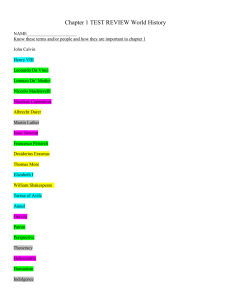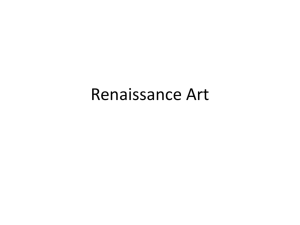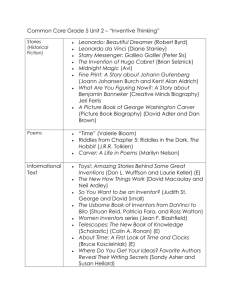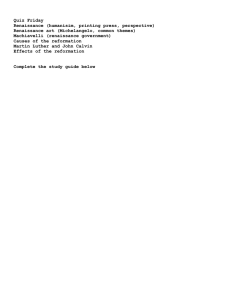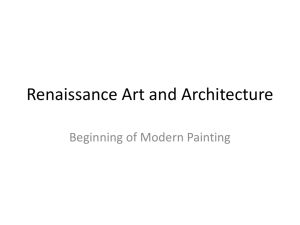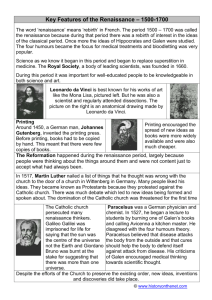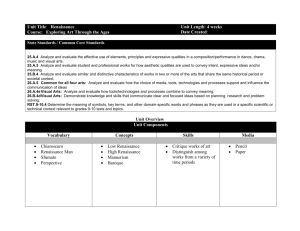AP World History: Transformation of the West 1450-1750
advertisement
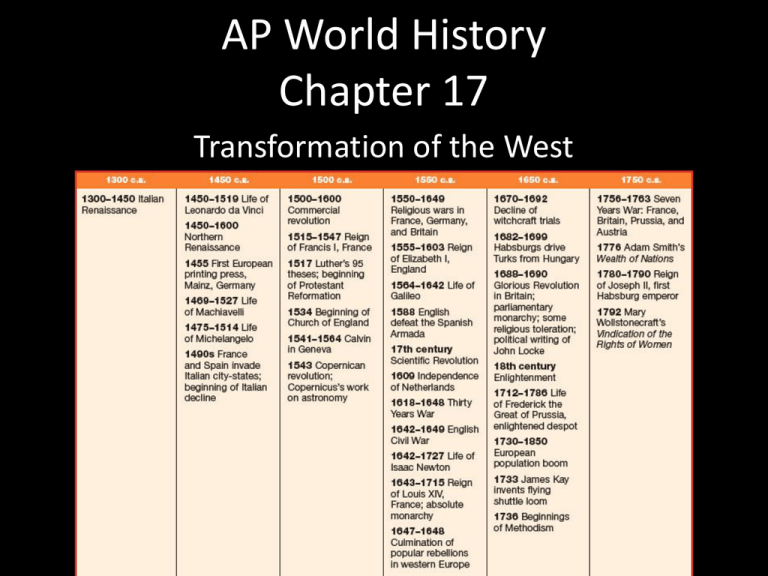
AP World History Chapter 17 Transformation of the West 1450-1750 The Italian Renaissance Begins 14th, 15th centuries • In northern Italy Italy • Urbanized • Merchant class • Political rivalry Petrarch, Boccaccio • Use Italian • Secular topics The Golden Age of the Arts • The Renaissance attained its most glorious expression in its paintings, sculptures, and architecture. • Renaissance artists revived many of the artistic styles of the Romans and Greeks. • Renaissance artists also developed the new form of art known as perspective. • Renaissance architects adopted the Roman and Greek styles of architecture. Leonardo • Leonardo da Vinci was born in 1452. • He was an engineer and an artist. • He would dissect corpses to learn how bones and muscles worked. • His paintings are known for their realistic nature. • Leonardo put many inventions to paper unfortunately not all of them were ever built. Lady with an ermine Mona Lisa The Last Supper Michelangelo • Born in 1475 Michelangelo was a many sided genius. • He was a sculptor, engineer, painter, architect, and poet. Pieta, Marble David, Marble Raphael • Born in 1483 he was younger then Leonardo and Michelangelo. He blended elements of Leonardo and Michelangelo. • He is best known for his paintings of the Madonna. Madonna Donatello • Born in 1386 Donatello became known for his shallow relief style of sculpting. • He made a living as a goldsmith prior to becoming a sculptor. David, Bronze Machiavelli’s “The Prince” • The Prince is a book that was written by Niccolo Machiavelli in 1513. • The book is a manual for how to gain and maintain power. • “The Prince” does not discuss leadership using high ideals. • The end always justified the means. Shakespeare • • • • English poet and playwright. Folly’s of young people in love. Power struggles of English kings. Tragedies of people being crushed by powerful forces or their own weaknesses. • Expanded the English language. The Renaissance Moves Northward Northern Renaissance • France, Low Countries, England, Germany • William Shakespeare • Miguel de Cervantes Changes in Technology and Family • Technology – printing • Family – Marriage age common – Nuclear family common Humanists • Stressed education of Classics. • Emphasized religious themes. • Called for the Bible to be translated into every day language. • Erasmus “Praise and Folly” – Humor to expose ignorant and immoral behavior. • Miguel de Cervantes “ Don Quixote” – Mocks romantic notions of medieval chivalry. • Thomas More “Utopia” – The ideal society. The Printing Revolution • Johann Gutenberg prints the first complete edition of the Bible using the first printing press and printing inks in the west in 1456. • The printing revolution had begun that would transform Europe. • By 1500 more then 20 million books had been printed. The Protestant and Catholic Reformations 1517, Martin Luther's challenge – Attacks church institutions – Bible the only authority – Vernacular translations Protestant protest used for political gain – German opposition to the papacy – Rulers seize church lands Spread of Luther’s Ideas • Many people supported Luther’s ideas for many different reasons. • German princes saw an opportunity to seize church lands. • Priests saw it as a way to reform church corruption. • Emperor Charles V of Germany fought several wars with German princes trying to force them back into the Catholic Church. • He eventually signed the Peace of Augsburg. This signaled the end of hostilities in Germany. “Whose rule, his religion” John Calvin • John Calvin was another reformer who believed in reforming the Church to do away with corruption. • Like Luther Calvin believed that salvation was gained through faith. • Calvin was asked to lead a community in Geneva where he set up a theocracy. Nicolaus Copernicus 1473-1543 • A Polish priest who studied astronomy. • He believed the earth was not the center of the universe. • He developed the heliocentric theory. – The idea that the sun was the center of the universe and the moon orbited the earth. • He did not publish his theories till he was dead for fear of attacks. Tyco Brahe 1546-1601 • Danish astronomer he created a measuring system to chart the positions of the planets. • He built on the theories of Nicolaus Copernicus. • He measured the positions of all the known planets and hundreds of stars. • Hired Johannes Kepler to be his assistant. Johannes Kepler 1571-1630 • Using information from both Copernicus and Brahe he confirmed that the sun was the center of the universe. • Discovered the orbits of planets to be oval and not circular. Galileo Galilei 1564-1642 • Galileo was a Renaissance man in that he studied and worked with many different things. • He discovered that all falling objects fall at the same speed no matter their weight. • He built a telescope that magnified objects so that he could see sunspots, and mountains on the moon. • Found four moons orbiting the planet of Jupiter. The Scientific Method • • • • • • Collect measurable data. Explain data using reasoning. Hypothesis on what data means. Test theory with observation and experimentation. Reach a conclusion about Hypothesis. Test observation and experimentation again. Bacon & Descartes • Two scientists from England and France. • They rejected Aristotle’s scientific assumptions. • Challenged the scholarly work of medieval universities that incorporated church doctrines. • Bacon used traditional experimentation mixed with observation. • Descartes used human reasoning. The doubter had to exist “I think, therefore I am” Isaac Newton 1642-1727 • In 1687 Newton published Mathematical Principles of Natural Philosophy. • He explained the law of gravity in the book. • He believed that all motion of the universe can be explained mathematically. • He linked physics and astronomy together. • Developed a new branch of math called calculus.
